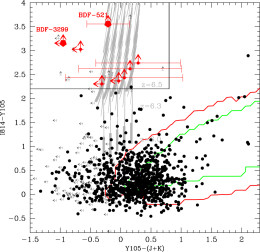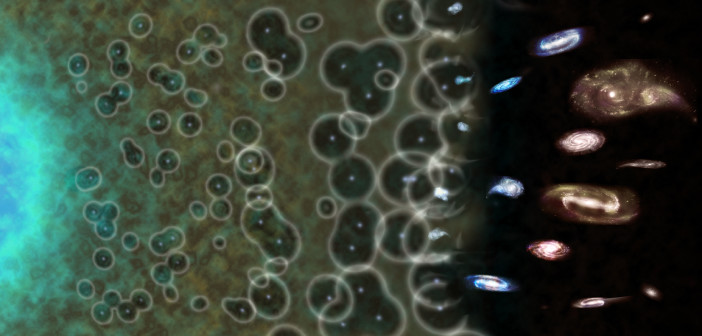During the period of reionization that followed the “dark ages” of our universe, hydrogen was transformed from a neutral state, which is opaque to radiation, to an ionized one, which is transparent to radiation. But what generated the initial ionizing radiation? The recent discovery of multiple distant galaxies offers evidence for how this process occurred.
Two Distant Galaxies
We believe reionization occurred somewhere between a redshift of z = 6 and 7, because Lyα-emitting galaxies drop out at roughly this redshift. Beyond this distance, we’re generally unable to see the light from these galaxies, because the universe is no longer transparent to their emission. This is not always the case, however: if a bubble of ionized gas exists around a distant galaxy, the radiation can escape, allowing us to see the galaxy.
This is true of two recently-discovered Lyα-emitting galaxies, confirmed to be at a redshift of z~7 and located near one another in a region known as the Bremer Deep Field. The fact that we’re able to see the radiation from these galaxies means that they are in an ionized HII region — presumably one of the earlier regions to have become reionized in the universe.
But on their own, neither of these galaxies is capable of generating an ionized bubble large enough for their light to escape. So what ionized the region around them, and what does this mean for our understanding of how reionization occurred in the universe?
A Little Help From Friends

Location in different filters of the objects in the Hubble Bremer Deep Field catalog. The z~7 selection region is outlined by the grey box. BDF-521 and BDF-3299 were the two originally discovered galaxies; the remaining red markers indicate the additional six galaxies discovered in the same region. [Castellano et al. 2016]
The authors believe these galaxies provide a simple explanation of the ionized bubble: each of these faint, normal galaxies produced a small ionized bubble. The overlap of these many small bubbles provided the larger ionized region from which the light of the two originally discovered galaxies was able to escape.
How normal is this clustering of galaxies found by Castellano and collaborators? The team demonstrates via cosmological modeling that the number density of galaxies in this region is a factor of 3–4 greater than would be expected at this distance in a random pointing of the same size.
These results greatly support the theoretical prediction that the first ionization fronts in the universe were formed in regions with significant galaxy overdensities. The discovery of this deep-field collection of galaxies strongly suggests that reionization was driven by faint, normal star-forming galaxies in a clumpy process.
Citation
M. Castellano et al 2016 ApJ 818 L3. doi:10.3847/2041-8205/818/1/L3

1 Comment
Pingback: cue up Don Ho singing "tiny bubbles"